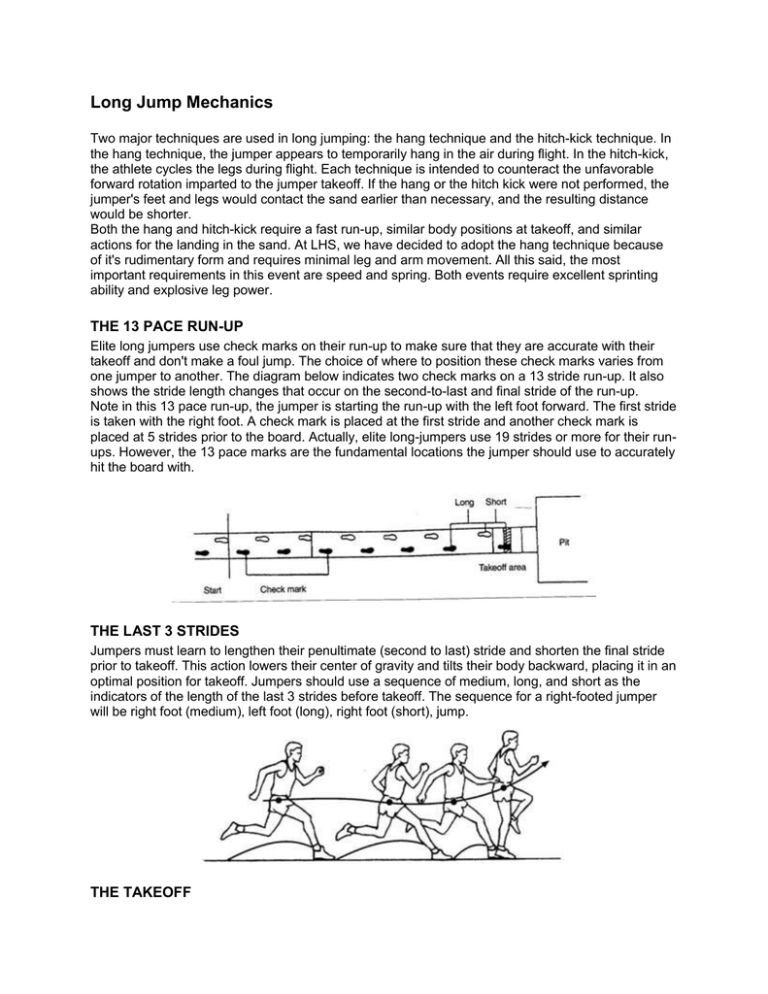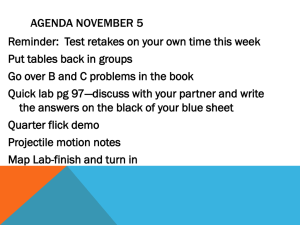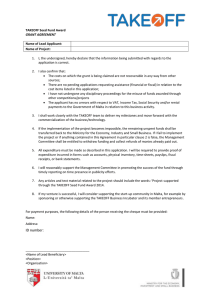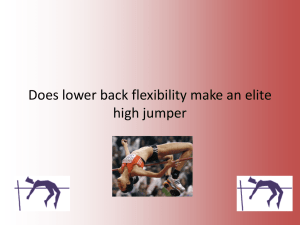Long Jump Mechanics
advertisement

Long Jump Mechanics Two major techniques are used in long jumping: the hang technique and the hitch-kick technique. In the hang technique, the jumper appears to temporarily hang in the air during flight. In the hitch-kick, the athlete cycles the legs during flight. Each technique is intended to counteract the unfavorable forward rotation imparted to the jumper takeoff. If the hang or the hitch kick were not performed, the jumper's feet and legs would contact the sand earlier than necessary, and the resulting distance would be shorter. Both the hang and hitch-kick require a fast run-up, similar body positions at takeoff, and similar actions for the landing in the sand. At LHS, we have decided to adopt the hang technique because of it's rudimentary form and requires minimal leg and arm movement. All this said, the most important requirements in this event are speed and spring. Both events require excellent sprinting ability and explosive leg power. THE 13 PACE RUN-UP Elite long jumpers use check marks on their run-up to make sure that they are accurate with their takeoff and don't make a foul jump. The choice of where to position these check marks varies from one jumper to another. The diagram below indicates two check marks on a 13 stride run-up. It also shows the stride length changes that occur on the second-to-last and final stride of the run-up. Note in this 13 pace run-up, the jumper is starting the run-up with the left foot forward. The first stride is taken with the right foot. A check mark is placed at the first stride and another check mark is placed at 5 strides prior to the board. Actually, elite long-jumpers use 19 strides or more for their runups. However, the 13 pace marks are the fundamental locations the jumper should use to accurately hit the board with. THE LAST 3 STRIDES Jumpers must learn to lengthen their penultimate (second to last) stride and shorten the final stride prior to takeoff. This action lowers their center of gravity and tilts their body backward, placing it in an optimal position for takeoff. Jumpers should use a sequence of medium, long, and short as the indicators of the length of the last 3 strides before takeoff. The sequence for a right-footed jumper will be right foot (medium), left foot (long), right foot (short), jump. THE TAKEOFF At takeoff, the jumper drives off a fully extended jumping leg and flexes the leading leg with the thigh raised to horizontal. The jumper’s upper body is perpendicular, the vision is ahead, and the jumper's arm actions compliment those of the legs. Long jumpers take off from ground level and want to travel as far as possible, so you might guess that their takeoff angle would be 45 degrees. But this is not the case. These athletes actually take off at an angle between 20 and 22 degrees. The long jumper would be forced to cut their speed down the runaway to take off at an angle of 45 degrees. No long jumper wants to do this because a reduction in approach speed drastically reduces the distance traveled in flight and the distance jumped. So long jumpers compromise between velocity at takeoff and takeoff angle. Velocity is the more important factor, and as a result, the takeoff angle is reduced from 45 degrees to 20 to 22 degrees. However, anything less from this angle will reduce distances significantly. THE CONSERVATION OF MOMENTUM The word conserve means to stay the same, or to be maintained. This applies to the amount of angular momentum an athlete position during a particular phase of a skill. For example, the angular momentum a jumper generates at takeoff remains the same while the jumper is in flight. Why? Because a jumper cannot push against the air to increase or decrease angular momentum. During flight the air has a negligible effect in reducing angular momentum. The only force that's working on the jumper is the earth's gravitational force, which pulls at her/his center of gravity. This force doesn't have any effect on the jumper's angular momentum, although gravity certainly increases her/his linear momentum as she/he accelerates toward the earth. Consequently, the jumper's angular momentum doesn't increase or decrease. It stays the same. This means that the angular momentum generated at takeoff is conserved during flight. THE FORWARD ROTATION All long jumpers rotate forward at takeoff. It's impossible to avoid because the takeoff foot pushing back at the board causes the jumper's body to rotate in the same direction as the direction of push of the takeoff foot. A long jumper taking off from left to right will push toward the left with the takeoff foot. In this case, the jumper will have given his body clockwise rotation. Worse still his/her body continues to rotate forward throughout his/her flight unless he/she does something about it. His/her legs and feet will rotate down toward the sand and the distance jumped will be greatly reduced. Novice jumpers who hold a bunched-up position in flight get themselves in trouble because a tightly flexed postion means that they also spin very quickly. As a result, a novice's body and feet quickly rotate down toward the sand, resulting in a poor distance. TO BATTLE THE FORWARD ROTATION To counteract unwanted forward rotation initiated at takeoff, an elite long jumper rotates the arms and legs in the same direction (i.e. forward) while in the air. This can stop their bodies from rotation forward and make them rotate in the opposing direction. This change in rotation helps them achieve a good body position for landing and so increase the distance jumped. Just how much reaction an athlete gets from rotating the arms and legs depends on how much angular momentum the athlete's body has been given at takeoff and how much angular momentum is introduced by the rotary motion of the arms and the legs. Vigorous rotary actions with arms and legs extended produce the most angular momentum. Look for elite long jumpers bringing their arms and legs forward in a flexed position and then rotating them backward in an extended position. This has maximum effect on counteracting the forward rotation of the jumpers' bodies. THE HANG After a fast run-up, the athlete drives up powerfully at takeoff. The athlete's leading leg, which is initially flexed and driven upward, is the extended and brought backward to join the take-off leg. Both legs, in their extended positions, are thrust to the rear of the body. The arms circle downward, backward, and then upward and forward. With the arms momentarily above the head, the jumper appears to hang in the air. The jumper's legs are flexed and thrust forward, and as they extend of the landing, the jumper's arms circle forward. As soon as contact with the sand is made, the jumper's legs flex at the knees, and the upper body moves forward and over the feet. The jumper's arm actions assist in driving the jumper forward beyond where the feet make contact with the sand. THE LANDING The magnitude (i.e. size) of the earth's reaction force pushing against a jumper depends on the how much the jumper pushes against the earth's surface. So the earth's reaction force depends not only on how much the jumper weighs but also on whatever movements the jumper makes. At the end of a long jump, the jumper exerts considerable force on the earth. The earth responds with an equal force against the jumper in teh opposing direction. Soft sand makes this force-counterforce comfortable and injury free of the jumper. ADDITIONAL POINTS TO REMEMBER 1. Try to hit the markers as you perform your 13 pace run-up. Remember that your first, ,second, and third strides will be sprinting strides during which you will be accelerating. 2. In your head, call out a rhythm as you approach the takeoff. The "daaa" sound indicates that your stride should be a long one. The quick "da" will indicate the short last stride....daa, daa, daa, daaaa, da, dap. is the replacement of med., med., med., long, short, jump strides. 3. At takeoff, thrust the thigh of the leading leg up and forward. 4. Drive powerfully with the jumping leg. 5. Once in the air, lower the leading leg and push your stomach forward to contact the cane or to open the "gate". 6. Remember that the motion of your arms is forward, down, back, up and then forward again. (This is initiated at the instant the athlete jumps upward). 7. Immediately after takeoff, flex your legs backward and pull them forward for the landing in the sand. 8. After takeoff, push your stomach forward. 9. In flight, as your arms come forward and downward, flex your legs and lift them up toward your arms for the landing. 10. Look forward, not downward, at takeoff. 11. Concentrate on making the changes in stride length, not on jumping far. 12. At takeoff, swing (drive) the thigh of your leading leg to horizontal and hold it in this position through to the landing. Don't be tempted to lower it while you're in the air. (Unless your trying the Hitch-Kick Technique).





